Choosing the best type of drill bit for metal can feel overwhelming with all the options available today. We want to help you make the right choice for your specific needs and budget. From basic DIY projects to heavy-duty industrial work, using the proper bit makes all the difference.
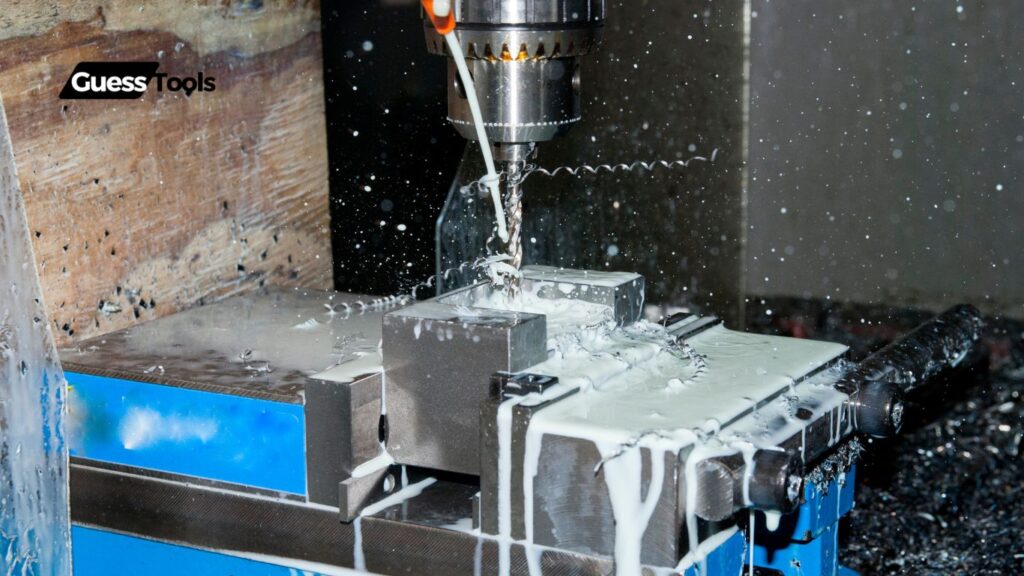
For most metal drilling tasks, cobalt drill bits offer the best combination of durability, heat resistance, and precision – especially when working with harder metals like stainless steel. These specialized bits cost more than standard ones, but their superior performance and longer lifespan make them worth the investment for regular metal work.
We’ve tested dozens of metal drill bits across different brands and materials to find what works best. Regular HSS (high-speed steel) bits can handle softer metals like aluminum, while titanium-coated bits offer good value for occasional use. For tougher jobs involving hardened steel, cobalt bits are the way to go. Let’s explore the top options to help you pick the perfect bit for your next metal drilling project.
Understanding Metal Drill Bits: A Quick Guide
Metal drill bits need special designs and materials to cut through tough materials safely and effectively. We’ll show you what makes these bits unique, why picking the right one matters, and the key terms you should know.
What Makes Metal Drill Bits Different
Metal drill bits have unique features that set them apart from regular bits. The most important is the huilun suunnittelu – those spiral grooves that help remove metal chips and keep the bit cool while drilling.
Se tip angle also matters. Most metal drill bits use either:
- 118° angle for softer metals
- 135° angle for harder metals
Materials are crucial too. The main types are:
- Nopea teräs (HSS) – good for basic metal work
- Cobalt Steel – handles tougher metals like stainless steel
- Carbide-Tipped – best for the hardest metals
Why Using the Right Bit Matters for Safety and Results
Using the wrong drill bit can be dangerous. The bit might break, which could send sharp pieces flying or damage your work piece.
The right bit will:
- Cut cleanly through the metal
- Create accurate hole sizes
- Last longer before wearing out
- Keep you safer while working
Speed matters too. We need to use slower speeds with metal bits than with wood bits. For example:
- Soft metals: 1000-3000 RPM
- Hard metals: 300-900 RPM
Key Terms You Need to Know
Point angle: The shape of the bit’s tip. A wider angle works better on harder metals.
Shank: The part that fits into your drill. Two common types:
- Round shank
- Hex shank (prevents slipping)
Coating types affect performance:
- Black oxide – basic protection
- Titaani – better heat resistance
- Gold oxide – superior lubrication
Look for bits marked “M2” tai “M35” – these numbers tell you the grade of high-speed steel used. M35 contains more cobalt and works better for tough metals.
Matching Best Type of Drill Bit for Metal Work
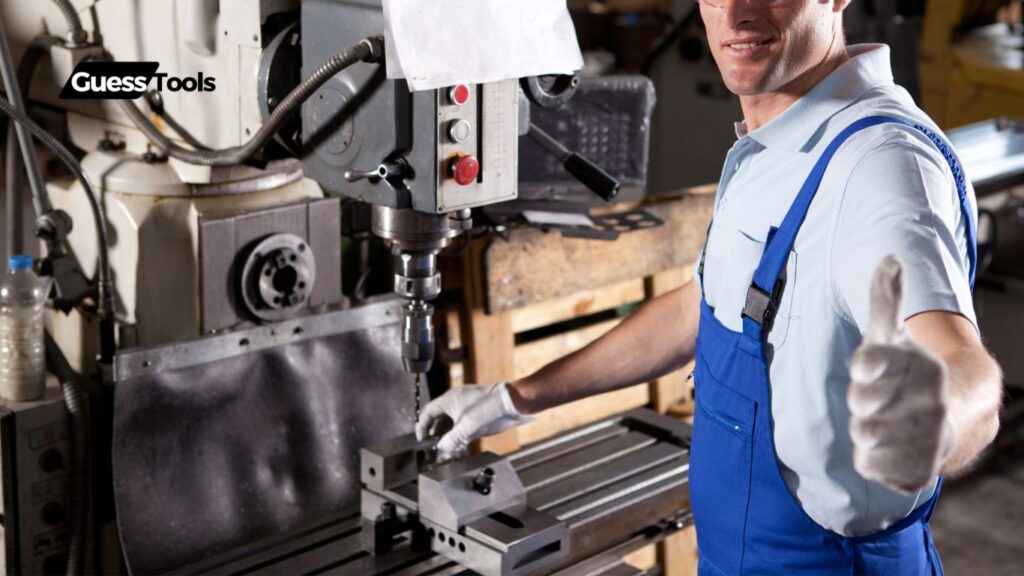
Different metals require specific drill bits for the best results and longest tool life. The right bit will give you clean holes while preventing damage to both your tools and materials.
Soft Metals (Aluminum, Brass): Best Bit Choices
High-speed steel (HSS) drill bits work great for softer metals. We recommend using bits with a 118-degree point angle for aluminum and brass, as this helps prevent the bit from grabbing or binding.
For aluminum, use cutting oil and run your drill at higher speeds. The soft nature of aluminum means standard HSS bits will do the job nicely.
Brass requires slower speeds to prevent chatter. Look for bits marked specifically for brass, as they have slightly different cutting geometries.
Common bit sizes for pehmeät metallit:
- 1/16″ 1/2″ for general work
- Split point designs help prevent walking
- Bright finish HSS is cost-effective
Hard Metals (Stainless Steel): What to Use
Cobalt drill bits are your best friend when working with stainless steel. These bits contain 5-8% cobalt mixed with HSS, making them extra tough and heat-resistant.
Use bits with a 135-degree split point to prevent walking on hard surfaces. This angle gives better penetration in tough materials.
Key features for stainless steel bits:
- M35 or M42 cobalt steel
- TiN coating for extra durability
- Tarvitaan hitaampia nopeuksia
- Regular cutting oil is essential
Special Cases and Problem Metals
Hardened steel needs special attention. We recommend using carbide-tipped bits for these challenging materials.
Titanium and similar super-alloys require:
- Heavy-duty cobalt bits
- Extra cutting fluid
- Very slow speeds
- Lots of pressure
Cast iron can be tricky. Use black oxide coated HSS bits with good lubrication.
Quick Reference Table for Metal Types and Bits
| Metal Type | Best Bit Choice | Speed | Coolant |
|---|---|---|---|
| Alumiini | Standard HSS | Korkea | Light oil |
| Messinki | Special brass bits | Keskipitkä | Optional |
| Ruostumaton teräs | Cobalt HSS | Matala | Required |
| Kovettu | Karbide-kärki | Very low | Required |
| Valurauta | Black oxide HSS | Keskipitkä | Required |
Types of Metal Drill Bits Compared
Different metal drill bits offer unique advantages for specific drilling tasks. The right choice depends on the metal you’re working with and how often you’ll use the bits.
High-Speed Steel (HSS): When to Use It
HSS bits are the most common choice for everyday metal drilling. We’ve found they work great on softer metals like aluminum and mild steel.
These bits typically cost $10-20 for a basic set. For better performance, look for HSS bits with titanium nitride (TiN) or black oxide coatings.
Key features of HSS bits:
- Heat resistant up to 600°F
- Good for speeds up to 1,500 RPM
- Work well on aluminum, brass, and mild steel
- Available in standard jobber lengths
The black oxide coating helps prevent rust and reduces friction during drilling.
Cobalt Bits: Benefits and Limitations
M35 and M42 cobalt bits contain 5-8% cobalt mixed with HSS. We recommend these for drilling harder metals like stainless steel.
Benefits of cobalt bits:
- Heat resistant up to 1,100°F
- Maintain sharpness longer than HSS
- Perfect for stainless steel and cast iron
- More durable than standard HSS
The main drawback is price – expect to pay 2-3 times more than HSS bits. A quality set starts around $40.
Split-point tips help prevent walking and create cleaner holes.
Solid Carbide: Worth the Investment?
Solid karbidipalat are the premium choice for serious metalworking. They excel at drilling the hardest metals.
Advantages of carbide bits:
- Extremely hard and wear-resistant
- Best for hardened steel and titanium
- Can drill at high speeds
- Last up to 10x longer than HSS
The steep price ($15-30 per bit) means they’re best for production work or specialty jobs.
Cost vs. Durability Comparison
| Materiaali | Cost Range | Durability Rating | Best Uses |
|---|---|---|---|
| HSS | $10-20/set | Hyvä | Aluminum, mild steel |
| Cobalt | $40-80/set | Very Good | Stainless steel, cast iron |
| Karbidi | $100-200/set | Erinomainen | Hardened steel, titanium |
We’ve seen HSS bits last 20-30 holes in mild steel. Cobalt bits often drill 100+ holes. Carbide can handle 200+ holes when used properly.
The flute design and point angle affect performance too. Look for 135° split points for most metal drilling tasks.
Step-by-Step Guide to Successful Metal Drilling
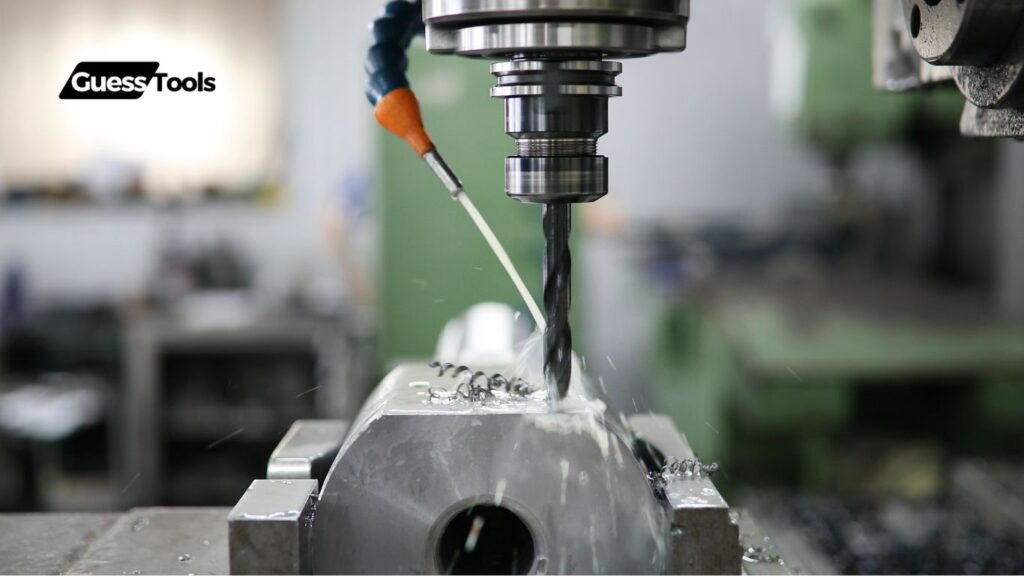
Safe and effective metal drilling requires proper preparation, technique, and attention to detail. Let’s walk through the essential steps to get professional results every time.
Pre-Drilling Checklist
Mark your drilling spot with a keskilyönti to prevent the drill bit from wandering. This small dimple will guide your bit exactly where you need it.
Select the right drill bit for your metal type:
- Titanium-coated: Good for mild steel and aluminum
- Cobalt steel: Best for hardened steel and stainless steel
- Karbide-kärki: Ideal for cast iron
Gather these essential tools:
- Safety glasses and gloves
- Cutting oil
- Variable speed drill or drill press
- Työkalu
- Clamps to secure your workpiece
Essential Safety Measures
Eye protection is non-negotiable. Metal chips can cause serious injury. Wear safety glasses that wrap around your face.
Keep long hair tied back and avoid loose clothing that could get caught in the drill.
Secure your workpiece firmly with clamps or a vise. Never hold the metal with your hands while drilling.
Clean your work area of debris and ensure proper lighting. A cluttered workspace leads to accidents.
Using Cutting Oil Correctly
Apply cutting oil before you start drilling and add more throughout the process. This keeps your bit cool and extends its life.
Different metals need different lubricants:
- Aluminum: WD-40 or kerosene
- Steel: Standard cutting oil
- Stainless steel: Sulfurized cutting oil
Add small amounts of oil frequently rather than flooding the work area at once.
Speed and Pressure Guidelines
Start slow to establish the hole, then increase speed gradually. Here’s a quick guide:
Recommended Speeds:
- Mild steel: 1,000-3,000 RPM
- Stainless steel: 500-1,000 RPM
- Aluminum: 2,000-4,000 RPM
Use light, steady pressure. Let the drill bit do the work. Pushing too hard causes heat buildup and can snap your bit.
Take breaks every few seconds when drilling thick metal to prevent overheating.
Troubleshooting Common Problems
Bit wandering? Make your center punch mark deeper or start with a smaller lentäjä.
Excessive heat? You’re either:
- Drilling too fast
- Not using enough cutting oil
- Applying too much pressure
Rough holes? Try:
- Reducing your speed
- Using a sharper bit
- Making a pilot hole first
If your bits keep breaking, you’re likely using too much pressure or the wrong bit type for your metal.
Extending Your Drill Bit Life
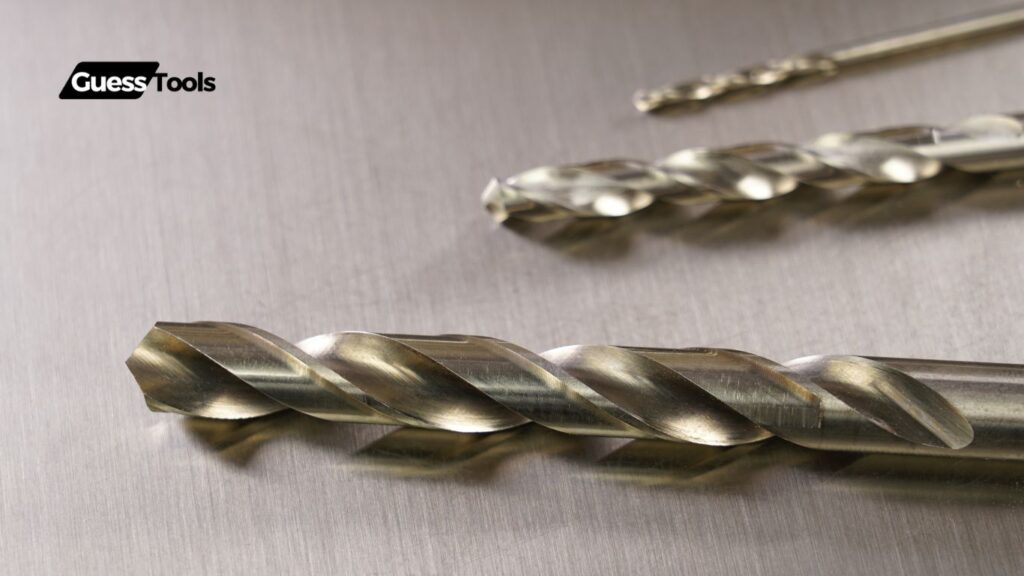
Taking proper care of your metal drill bits will help them last longer and perform better. Let’s look at the key practices that will save you money and keep your bits drilling smoothly.
Storage Best Practices
Store your drill bits in a dedicated case or holder to protect them from moisture and damage. We recommend using cases with individual slots for each bit.
Keep bits in a dry place away from extreme temperatures. A climate-controlled toolbox or drawer works great.
Pro Tip: Use silica gel packets in your storage container to prevent rust and corrosion.
Organize bits by size and type. This prevents them from bumping against each other and getting damaged.
Cleaning and Maintenance Tips
Clean bits after each use with a wire brush to remove metal shavings and debris. This prevents rust and keeps cutting edges sharp.
Apply a light coat of machine oil or WD-40 to protect bits from moisture.
Key maintenance steps:
- Use cutting oil while drilling
- Keep bits at proper drilling speeds
- Let bits cool between uses
- Remove buildup regularly
When and How to Sharpen
Check bit sharpness by looking at the cutting edges under good light. Dull edges will appear rounded or shiny.
Sharpening steps:
- Use a bench grinder with fine wheel
- Hold bit at 59-degree angle
- Rotate bit while grinding
- Keep bit cool with water
- Test sharpness on scrap metal
Don’t sharpen more than 2-3 times – bits become too weak after multiple sharpenings.
Signs It’s Time to Replace
Watch for these warning signs:
- Squealing or chattering during drilling
- Excess pressure needed to cut
- Smoke while drilling
- Uneven or rough holes
- Visible chips or cracks
- Severely rounded cutting edges
Replace bits showing these signs immediately. Using worn bits is dangerous and leads to poor results.
Use fresh, sharp bits for important projects that need clean holes.
Expert Tips and Techniques
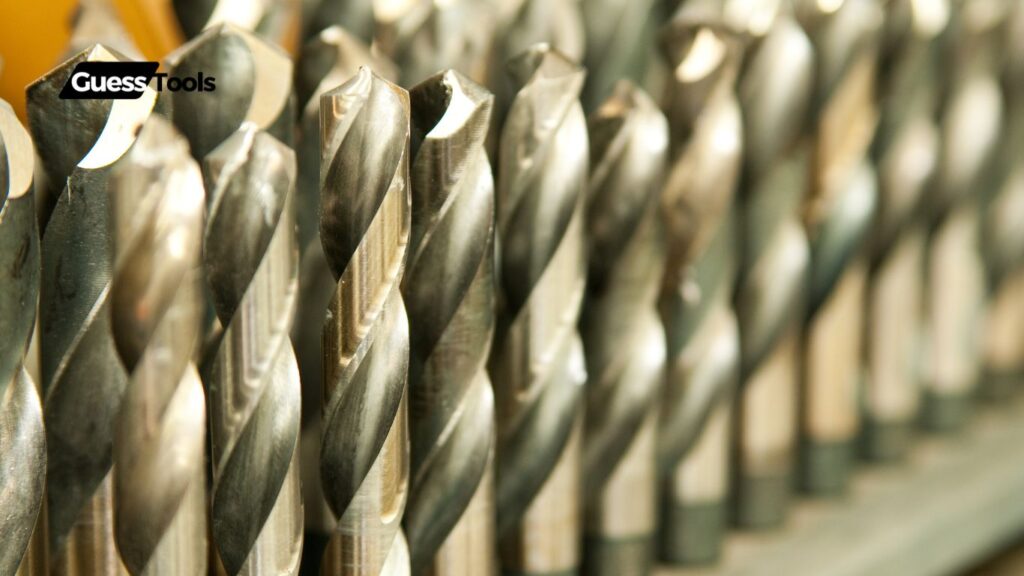
Getting perfect holes in metal requires proper technique and the right approach. These proven methods will help you drill with precision and confidence.
Starting Holes Accurately
A center punch is your best friend for marking drill spots. Place it exactly where you want to drill and tap it firmly with a hammer to create a small dimple.
We recommend starting with a small pilot drill bit (1/8 inch or less) before switching to your final size. This helps guide the larger bit.
Use low speed when starting the hole. Press firmly but don’t force it – let the drill do the work.
Pro tip: Mark your drilling spot with a piece of masking tape. Draw your center point on the tape for better visibility.
Preventing Bit Wandering
Drill bits can slide across metal surfaces if you’re not careful. Here’s how to keep them steady:
- Start at slow speeds (300-400 RPM)
- Apply firm, constant pressure
- Keep the drill perpendicular to the surface
- Use neste or oil to reduce friction
Quick trick: Clamp a piece of scrap wood against your metal. Drill through both – the wood helps guide your bit.
Dealing with Tough Materials
Hardened steel and stainless steel need special attention:
- Use cobalt or titanium-coated bits
- Apply cutting fluid generously
- Reduce speed by 50% compared to soft metals
- Take breaks to prevent overheating
Keep steady pressure and watch for color changes in the metal. If it turns blue, you’re going too fast.
Professional Shortcuts and Methods
Speed up your work with these field-tested techniques:
Start with a smaller bit size and work up gradually. This puts less strain on your tools and gives cleaner results.
Essential safety gear:
- Safety glasses
- Work gloves
- Face shield for large jobs
Time-saving tip: Pre-mark all your holes before starting. This helps you work efficiently and maintain consistent spacing.
Use a drill press when possible – it gives you better control and more precise holes.
Recommended Drill Bit Sets

Metal drilling success depends on choosing the right drill bit set that matches your needs and budget. The best sets combine durability with versatility while staying within your price range.
Budget-Friendly Options
The DEWALT DWA1181 21-piece set gives you great value for basic metal drilling tasks. We found these bits work well for DIY projects and light workshop use.
Key features:
- 135-degree split points for clean starts
- Sizes from 1/16″ 1/2″
- Works on wood, plastic, and metal
- Durable black oxide coating
The Bosch 21-piece Black Oxide set offers another solid budget choice. These bits handle most common metals well and resist wear better than basic bits.
Professional-Grade Picks
For serious metalworking, we recommend the Drill America D/A29J-CO-PC cobalt set. These bits excel at drilling hardened steel and stainless steel.
Premium features:
- M35 cobalt steel construction
- Split point design prevents walking
- Heat resistant up to 1100°F
- Gold oxide finish reduces friction
The IRWIN Unibit step drill set is perfect for sheet metal work. Each bit drills multiple hole sizes, saving time and money.
Best Value for Money
The DeWalt DWA1240 14-piece cobalt set hits the sweet spot between quality and cost. The cobalt blend outperforms titanium-coated bits on tough metals.
What’s included:
- Sizes 1/16″ 3/8″
- Heavy-duty storage case
- Web-thinned design for faster cutting
- No-spin shanks
What to Look for in a Quality Set
A good drill bit set needs these key features:
- Split point tips for precise starts
- Durable coating (black oxide, cobalt, or titanium)
- Common sizes from 1/16″ to at least 3/8″
- Sturdy case for organization and protection
Look for bits made from high-speed steel (HSS) at minimum. Cobalt steel is worth the extra cost for frequent metal drilling.
The right angle matters too. We prefer 135-degree tips for most metal work. This angle gives you clean holes without the bit walking across the surface.







